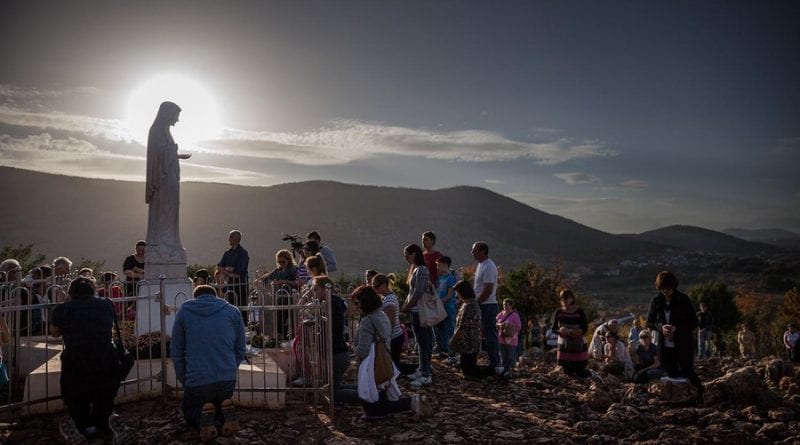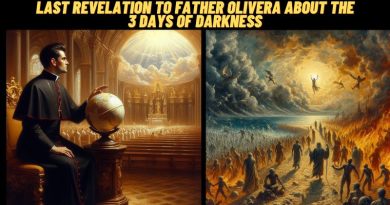Book convincingly shows that Reagan was well aware of, and believed in, the Marian apparitions in Fatima and Medjugorje…Did his belief in Marian Apparition lead to the defeat of the Soviet Union and end the Cold War?
The most fascinating and surprising find of Kengor’s research is that the Protestant Reagan’s moral fight for liberty in Russia and Eastern Europe was not only to a large extent informed by Catholicism (the president’s father and brother were Catholics), but was also Marian in nature. Kengor convincingly shows that Reagan was well aware of, and may have privately believed in, the Marian apparitions in Fatima and Medjugorje.
Published in Catholic World Report
Paul Kengor’s A Pope and a President: John Paul II, Ronald Reagan, and the Extraordinary Untold Story of the 20th Century provides much hitherto unknown, surprising information about the fortieth president of the United States. It is difficult to deny that President Reagan’s uncompromising stance towards the Soviet “Evil Empire” was one of the major causes of the end of the Cold War. When describing Reagan’s contributions to the fall of the Iron Curtain, a traditional scholar would above all centers on the Reagan administration’s increase of defense spending and policies such as Strategic Defense Initiative (SDI), mockingly called “star wars” by the president’s critics.
Paul Kengor, however, is not a traditional scholar. Instead, he focuses on the moral and, yes, religious aspect of Ronald Reagan’s struggle against communism. This book naturally complements Kengor’s 2006 work The Crusader: Ronald Reagan and the Fall of Communism, which particularly concentrates on Reagan’s intellectual journey from that of an FDR Democrat to becoming convinced that the Soviet Union was a threat to human existence and on his strong support for Solidarity in Poland.

In A Pope and a President, Kengor again effectively demonstrates that for Reagan the crusade against the Soviet Union was not primarily motivated by the pursuit of superpower dominance, but by a genuine desire to liberate hundreds of millions of people from the communist yoke. Kengor argues that Reagan’s anti-communism had a strong religious component; he chronicles, for example, how the president pushed Mikhail Gorbachev, the last Soviet general secretary, to grant religious liberty to oppressed groups of believers in the Soviet Union, such as Ukrainian Greek-Catholics and Jews (Nathan Sharansky, the famous Russian-Jewish gulag prisoner denied permission to leave the USSR who would later be a prominent figure in Israeli politics, was released by Gorbachev due to pressure from Reagan).
The most fascinating and surprising find of Kengor’s research is that the Protestant Reagan’s moral fight for liberty in Russia and Eastern Europe was not only to a large extent informed by Catholicism (the president’s father and brother were Catholics), but was also Marian in nature. Kengor convincingly shows that Reagan was well aware of, and may have privately believed in, the Marian apparitions in Fatima and Medjugorje (the latter, controversial among some Catholics, have not been recognized by the Catholic Church). During the Cold War, Kengor argues, both shrines were well known to anti-communists; after all, Mary told the shepherd children in the Portuguese village to pray for the conversion of Russia, while the alleged Medjugorje apparitions occurred in communist Yugoslavia. Kengor cites, for example, Reagan’s speech to Portugal’s Parliament (overshadowed by the president’s controversial visit to the German military cemetery at Bitburg, where SS-men were buried, during the same European tour) in which he directly referenced Fatima.
At Reagan’s funeral in Washington’s National Cathedral, Irish tenor Ronan Tynan sang “Ave Maria.” Thanks to his research, Kengor has confirmed that this performance was much more than a tribute to the Irish-American president’s ethnic origins: before becoming stricken with Alzheimer’s, Reagan requested that “Ave Maria” be sung at his funeral. Given all these revelations of Ronald Reagan’s ties to Catholicism and Mary, one can only wonder why the president never became Catholic.
A “partnership” between the pope and president?
Like President Reagan, Pope St. John Paul II is often cited as one of the historical figures most responsible for the demise of European communism. Very often, his contribution to the end of the Cold War is presented more or less like this: in 1978, a Pole was elected pope, the first non-Italian pope in 455 years. The following year, he traveled to his communist-ruled homeland, and the pilgrimage galvanized his countrymen, leading to the rise of Solidarity, whose eventual success led to a chain reaction of anti-communist rebellions across Eastern Europe in 1989.
Naturally, Kengor’s account contains this history. However, it is much deeper than that. In addition to familiar stories of Archbishop (and later Cardinal) Karol Wojtyła struggling against atheist state Marxism-Leninism in his native Poland before becoming pope, Paul Kengor writes about the myopic policy of Ostpolitik pursued by the Vatican before John Paul’s election. Kengor illustrates this naïve policy under popes John XXIII and Paul VI that consisted of trying to negotiate better conditions for Catholics under communist regimes by avoiding provoking them, with the example of Hungarian Cardinal Jozsef Mindszenty, an outspoken opponent of the communist regime whom the Vatican refused to support in the 1960s and 1970s.
Kengor compares Vatican Ostpolitik, which John Paul II definitively broke with, to Washington’s policy of détente, of which Reagan was a critic and which was pursed not only by Democratic but also Republican presidents including Gerald Ford and Richard Nixon. Thus Kengor presents both leaders as often working against their establishments, ultimately proving successful.
Although the pope and president met in person only five times, Paul Kengor makes it clear that the men not only admired each other; they frequently corresponded and cooperated in the struggle for the liberation of the captive nations of Eastern Europe. Drawing on interviews with Reagan administration officials as well as archives from the Ronald Reagan Presidential Library and the Vatican (many documents, Kengor notes, will remain redacted or classified for many years to come), Kengor shows that the two men often consulted with each other and took each other’s advice seriously. For example, he notes that John Paul II successfully persuaded Reagan to scrap plans to impose sanctions on Poland after General Wojciech Jaruzelski had declared martial law on Solidarity; the pope argued that sanctions would bring much suffering to the Polish people.
Although Paul Kengor frequently refers to Pope John Paul II and Ronald Reagan as “partners,” reading his book I could not help but keep thinking that although the two men clearly respected each other, their opinions on topics other than the communist domination of Eastern Europe frequently diverged. Unfortunately, Kengor does not discuss this at all.




